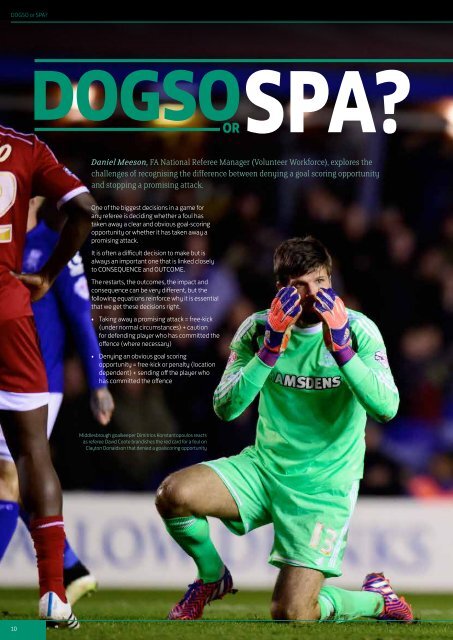Ken Aston MBE
10223_Referee-Magazine-Vol-26_LR
10223_Referee-Magazine-Vol-26_LR
- No tags were found...
You also want an ePaper? Increase the reach of your titles
YUMPU automatically turns print PDFs into web optimized ePapers that Google loves.
DOGSO or SPA?<br />
DOGSOSPA?<br />
or<br />
Daniel Meeson, FA National Referee Manager (Volunteer Workforce), explores the<br />
challenges of recognising the difference between denying a goal scoring opportunity<br />
and stopping a promising attack.<br />
One of the biggest decisions in a game for<br />
any referee is deciding whether a foul has<br />
taken away a clear and obvious goal-scoring<br />
opportunity or whether it has taken away a<br />
promising attack.<br />
It is often a difficult decision to make but is<br />
always an important one that is linked closely<br />
to CONSEQUENCE and OUTCOME.<br />
The restarts, the outcomes, the impact and<br />
consequence can be very different, but the<br />
following equations reinforce why it is essential<br />
that we get these decisions right.<br />
• Taking away a promising attack = free-kick<br />
(under normal circumstances) + caution<br />
for defending player who has committed the<br />
offence (where necessary)<br />
• Denying an obvious goal scoring<br />
opportunity = free-kick or penalty (location<br />
dependent) + sending off the player who<br />
has committed the offence<br />
Middlesbrough goalkeeper Dimitrios Konstantopoulos reacts<br />
as referee David Coote brandishes the red card for a foul on<br />
Clayton Donaldson that denied a goalscoring opportunity<br />
RecogniseDistinguishReact<br />
How we recognise and distinguish between these types of offences<br />
can often be difficult. As referees we make hundreds of decisions and<br />
non-decisions each game, often at great speed and so judging the<br />
fine margins between the two types of offence can be hard to detect<br />
and deal with.<br />
Fortunately there are tools that we have at our disposal to help us<br />
when confronted with this challenge.<br />
Laws of the Game<br />
If in doubt, always remember what the Laws of the Game tell us in<br />
relation to what a referee must consider when deciding whether<br />
or not to send a player off for denying an obvious goal scoring<br />
opportunity.<br />
1. DISTANCE – Between the offence and the goal<br />
2. CONTROL – The likelihood of keeping or gaining control<br />
of the ball<br />
3. DIRECTION – The direction of play<br />
4. DEFENDERS – Location and number of defenders<br />
5. OFFENCE – The offence that denies an opponent a goal<br />
scoring opportunity may be an offence that incurs<br />
a direct or in-direct free-kick<br />
Unfortunately, the Laws of the game do not provide guidance and<br />
clarity around what constitutes a promising attack.<br />
Players, coaches and often the spectators watching the game can<br />
provide you with useful indicators for what a promising attack is,<br />
but we must be careful to not use these external factors as our only<br />
influence.<br />
Therefore we must refer back to our bullet points in the Laws of the<br />
Game around the denial of an obvious goal scoring opportunity and<br />
work to check and challenge before making that ultimate decision.<br />
What can we use to help?<br />
These kinds of decisions can be quite common. Rarely will a season go<br />
by where a referee does not have to make a judgement on whether<br />
the offence has taken away an obvious goal scoring opportunity or<br />
a promising attack. Some offences are very clear but for some of the<br />
tighter, more borderline incidents we need to recognise, distinguish<br />
and react accordingly.<br />
With this in mind, we can use a quick and easy acronym to help us<br />
make the right decision - the F.A.T Referee.<br />
F = Freeze frame and focus<br />
A = Analyse the actuals<br />
T = Take the picture, take your time and take action<br />
10<br />
11


